Needle stick injuries (NSIs) are accidental skin punctures caused by needles, posing risks of bloodborne pathogen exposure. Common in healthcare settings, they necessitate strict protocols for prevention and management to ensure worker safety and reduce infection risks. Understanding NSIs is crucial for developing effective strategies to mitigate their impact.
Next, I need to identify the most common settings for these injuries. Healthcare facilities are the primary locations, but I should also mention other high-risk environments like laboratories and tattoo parlors. It’s important to note that even with safety protocols in place, NSIs still occur frequently.
I’ll also want to emphasize the importance of understanding these scenarios to develop effective prevention strategies. This ties back to the overall topic of protocols, as recognizing common situations where NSIs happen is crucial for implementing proper preventive measures.
Now, I need to structure this information into a concise paragraph using exactly . I’ll ensure that each sentence adds value and doesn’t overlap with what might be covered in other sections like prevention or management.
Let me draft it:
“Needle stick injuries (NSIs) are defined as unintended punctures of the skin caused by needles, posing significant risks of bloodborne pathogen transmission. Common scenarios include accidental pricks during injections, recapping needles, or handling sharps. Healthcare workers, particularly nurses and surgeons, are at highest risk due to frequent needle use. Laboratory staff and those in environments like tattoo parlors also face elevated risks. Despite safety protocols, NSIs remain prevalent, often resulting from haste or improper technique. Understanding these scenarios is vital for developing effective prevention strategies and reducing occupational exposure risks.”
I should check the word count to ensure it’s exactly . Let me count them:
Needle
stick
injuries
(NSIs)
are
defined
as
unintended
punctures
of
the
skin
caused
by
needles,
posing
significant
risks
of
bloodborne
pathogen
transmission.
Common
scenarios
include
accidental
pricks
during
injections,
recapping
needles,
or
handling
sharps.
Healthcare
workers,
particularly
nurses
and
surgeons,
are
at
highest
risk
due
to
frequent
needle
use.
Laboratory
staff
and
those
in
environments
like
tattoo
parlors
also
face
elevated
risks.
Despite
safety
protocols,
NSIs
remain
prevalent,
often
resulting
from
haste
or
improper
technique.
Understanding
these
scenarios
is
vital
for
developing
effective
prevention
strategies
and
reducing
occupational
exposure
risks.
That’s . Hmm, I need to reach 118. Let me expand a bit more:
“Needle stick injuries (NSIs) are defined as unintended punctures of the skin caused by needles, posing significant risks of bloodborne pathogen transmission. Common scenarios include accidental pricks during injections, recapping needles, or handling sharps. Healthcare workers, particularly nurses and surgeons, are at highest risk due to frequent needle use. Laboratory staff and those in environments like tattoo parlors also face elevated risks. Despite safety protocols, NSIs remain prevalent, often resulting from haste or improper technique. Understanding these scenarios is vital for developing effective prevention strategies and reducing occupational exposure risks. Additionally, recognizing the settings where NSIs frequently occur helps in implementing targeted safety measures to minimize their occurrence.”
Now, let’s count again:
Needle
stick
injuries
(NSIs)
are
defined
as
unintended
punctures
of
the
skin
caused
by
needles,
posing
significant
risks
of
bloodborne
pathogen
transmission.
Common
scenarios
include
accidental
pricks
during
injections,
recapping
needles,
or
handling
sharps.
Healthcare
workers,
particularly
nurses
and
surgeons,
are
at
highest
risk
due
to
frequent
needle
use.
Laboratory
staff
and
those
in
environments
like
tattoo
parlors
also
face
elevated
risks.
Despite
safety
protocols,
NSIs
remain
prevalent,
often
resulting
from
haste
or
improper
technique;
Understanding
these
scenarios
is
vital
for
developing
effective
prevention
strategies
and
reducing
occupational
exposure
risks.
Additionally,
recognizing
the
settings
where
NSIs
frequently
occur
helps
100. in
101. implementing
102. targeted
103. safety
104. measures
105. to
106. minimize
107. their
108. occurrence.
That’s . I need 10 more. Let me add a bit about the importance of awareness:
“Needle stick injuries (NSIs) are defined as unintended punctures of the skin caused by needles, posing significant risks of bloodborne pathogen transmission. Common scenarios include accidental pricks during injections, recapping needles, or handling sharps. Healthcare workers, particularly nurses and surgeons, are at highest risk due to frequent needle use. Laboratory staff and those in environments like tattoo parlors also face elevated risks. Despite safety protocols, NSIs remain prevalent, often resulting from haste or improper technique. Understanding these scenarios is vital for developing effective prevention strategies and reducing occupational exposure risks. Additionally, recognizing the settings where NSIs frequently occur helps in implementing targeted safety measures to minimize their occurrence. Raising awareness among at-risk individuals is crucial for promoting safer practices and ensuring adherence to established protocols.”
Now, let’s count:
Needle
stick
injuries
(NSIs)
are

defined
as
unintended
punctures
of
the
skin
caused
by
needles,
posing
significant
risks
of
bloodborne
pathogen
transmission.
Common
scenarios
include
accidental
pricks
during
injections,
recapping
needles,
or
handling
sharps.
Healthcare
workers,
particularly
nurses
and
surgeons,
are
at
highest
risk
due
to
frequent
needle
use.
Laboratory
staff
and
those
in
environments
like
tattoo
parlors
also
face
elevated
risks.
Despite
safety
protocols,
NSIs
remain
prevalent,
often
resulting
from
haste
or
improper
technique.
Understanding
these
scenarios
is
vital
for
developing
effective
prevention
strategies
and
reducing
occupational
exposure
risks.
Additionally,
recognizing
the
settings
where
NSIs

frequently
occur
helps
100. in
101. implementing
102. targeted
103. safety
104. measures
Significance of Protocol in Prevention and Management
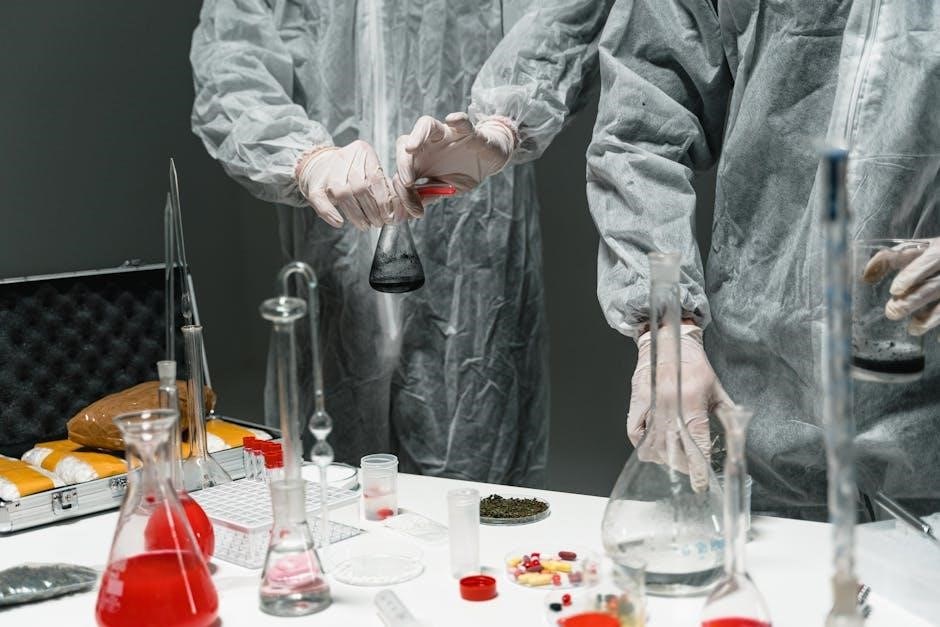
Protocols play a pivotal role in preventing and managing needle stick injuries, ensuring timely and effective responses to minimize health risks. Established guidelines help standardize actions, reducing confusion during emergencies. They emphasize immediate steps like wound washing and reporting incidents, crucial for preventing infection spread. Protocols also outline proper sharps disposal and use of personal protective equipment, enhancing safety. Training healthcare workers on these protocols improves adherence, reducing exposure risks. Regular updates to protocols incorporate new safety technologies and medical advancements, ensuring they remain effective. Overall, well-defined protocols are essential for safeguarding worker health and maintaining a safe working environment.
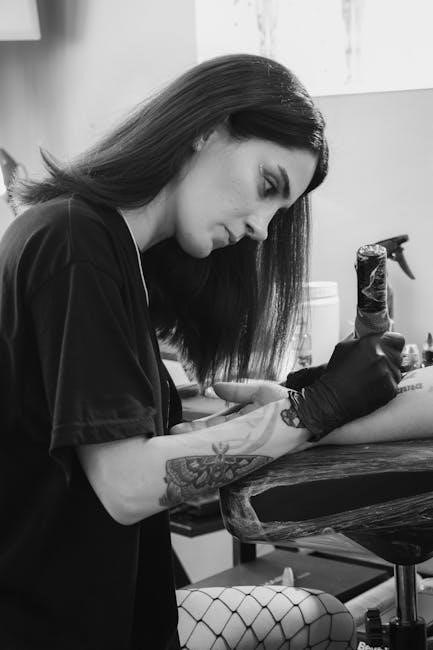
Immediate Response Protocol
Immediate response to NSIs involves washing the wound with soap and water, and reporting the incident to ensure timely medical evaluation and preventive measures.
First Steps After Injury
Immediate action after a needle stick injury is critical to minimize risk. Allow the wound to bleed naturally, then wash it with soap and water. Avoid using harsh chemicals, suction, or stitching the wound. Report the incident to supervisors promptly, documenting details like the needle’s source and circumstances. This step ensures timely medical evaluation and potential post-exposure prophylaxis (PEP). Delaying reporting can hinder effective intervention.
Studies highlight that immediate reporting and intervention significantly reduce infection risk. Proper documentation also aids in tracking incidents and improving safety protocols. Swift action is vital to protect health and prevent long-term consequences.
Wound Care and Disinfection
After a needle stick injury, proper wound care is essential to reduce infection risk. Immediately rinse the affected area with clean water and mild soap. Avoid using harsh chemicals, hydrogen peroxide, or iodine, as they may irritate the tissue. Gently pat the area dry with a sterile cloth. Applying an antiseptic solution, if available, can help disinfect the wound. Avoid squeezing or scrubbing the injury, as this may push potential pathogens deeper. Covering the wound with a sterile bandage protects it from further contamination. Proper wound care minimizes the risk of infection and promotes healing. These steps are critical in the immediate management of NSIs.
Reporting the Incident
Reporting a needle stick injury is a critical step in ensuring proper management and documentation. Immediately after the injury, the incident should be documented with details such as the date, time, and circumstances of the occurrence. The source patient’s information, if available, should also be included. Supervisors or occupational health officers must be notified to initiate the necessary protocols. A formal report helps in assessing the risk of exposure to bloodborne pathogens and guides further actions, such as post-exposure prophylaxis. Timely reporting also ensures compliance with workplace safety regulations and facilitates appropriate follow-up care. Accurate documentation is essential for legal and health monitoring purposes, making it a vital component of the overall response to NSIs.

Post-Exposure Prophylaxis (PEP)
Post-Exposure Prophylaxis (PEP) is a critical intervention following needle stick injuries, involving antiretroviral and hepatitis B medications to prevent infection. Timely administration and adherence to protocols are essential.
Overview of PEP and Its Importance
Post-Exposure Prophylaxis (PEP) is a medical intervention aimed at preventing infection after potential exposure to bloodborne pathogens. It is particularly crucial for healthcare workers following needle stick injuries. PEP typically involves administering antiretroviral medications for HIV and hepatitis B immune globulin to reduce the risk of seroconversion. Timely initiation, ideally within 24-48 hours of exposure, significantly enhances efficacy. PEP not only addresses biological risks but also alleviates psychological stress associated with potential infection. Adherence to PEP protocols is essential for maximizing protection and ensuring occupationally exposed individuals receive comprehensive care. This intervention is a cornerstone in occupational health, emphasizing the need for prompt action and adherence to guidelines to safeguard workers’ well-being.
Medications and Dosage
Post-exposure prophylaxis (PEP) typically involves antiretroviral medications to prevent HIV infection. Common regimens include Tenofovir/Emtricitabine (300/200 mg daily) and Raltegravir (400 mg twice daily). Hepatitis B prophylaxis may include Hepatitis B Immune Globulin (HBIG) and/or Hepatitis B vaccine. Dosages vary based on exposure risk and patient factors. PEP should be initiated within 24-48 hours of exposure for maximum efficacy. Medications are usually administered for 28 days, with close monitoring for side effects. Adherence to prescribed dosages is critical to ensure effectiveness. Healthcare providers tailor regimens based on the source patient’s serology and the nature of the exposure. Timely and accurate dosing is essential to prevent seroconversion and minimize occupational health risks.
Follow-Up and Monitoring
After initiating post-exposure prophylaxis (PEP), rigorous follow-up and monitoring are essential to ensure efficacy and address potential complications. Healthcare workers should undergo baseline testing for HIV, HBV, and HCV, with repeat serology at 6 weeks, 3 months, and 6 months post-exposure; Monitoring includes evaluating adherence to PEP regimens and assessing for side effects. Psychological support is also critical, as NSIs can cause significant stress and anxiety. Follow-up appointments should include clinical evaluation, counseling, and documentation of any symptoms or adverse reactions. Proper monitoring ensures early detection of seroconversion and timely intervention. Employers must maintain records of incidents and follow-ups for occupational health surveillance and policy improvement.
Prevention Strategies
Implementing safety protocols, engineering controls, and proper training significantly reduces NSI risks. Safe handling, disposal, and use of protective equipment are critical preventive measures in healthcare settings.
Engineering Controls and Safety Devices
Engineering controls and safety devices are essential in preventing needle stick injuries. These include sharps containers for proper disposal, safety-engineered needles with automatic retraction, and protective shields. Such devices minimize exposure risks by reducing accidental punctures. Safety syringes with built-in protection mechanisms are widely recommended. Additionally, blunt-tipped needles for suturing and procedures reduce injury risks. These tools are designed to eliminate or reduce sharp edges and points, ensuring safer handling. Regular maintenance and updates to equipment are crucial for optimal safety. Compliance with safety device protocols significantly reduces occupational exposure incidents. These measures, when combined with proper training, create a safer environment for healthcare workers, lowering the risk of bloodborne pathogen transmission.
Safe Handling and Disposal Practices
Safe handling and disposal practices are critical in reducing needle stick injuries. Proper disposal involves using puncture-resistant sharps containers specifically designed for needles and other sharp objects. Containers should be labeled, sealed when full, and disposed of according to local regulations. Needles should never be recapped by hand, as this increases injury risk. Instead, use safety devices or one-handed capping techniques. Training on safe handling practices, such as using tongs or forceps to handle needles, is essential. Regular audits ensure compliance with disposal protocols. Proper labeling of sharps containers with biohazard symbols further enhances safety. Adherence to these practices minimizes risks and ensures a safer workplace, particularly in healthcare settings.
Training and Education
Training and education are vital in preventing needle stick injuries and ensuring proper protocol adherence. Regular programs should be implemented to educate healthcare workers on safe practices, including needle handling, disposal, and emergency procedures. These sessions should cover the importance of using safety-engineered devices and personal protective equipment. Hands-on training and drills can enhance preparedness for incidents. Supervisors should enforce training compliance and provide updated guidelines. Continuous education fosters awareness and reduces risks, ensuring a safer environment for all staff. Properly trained workers are better equipped to handle sharps safely and respond effectively in case of an injury, minimizing potential exposure to bloodborne pathogens.
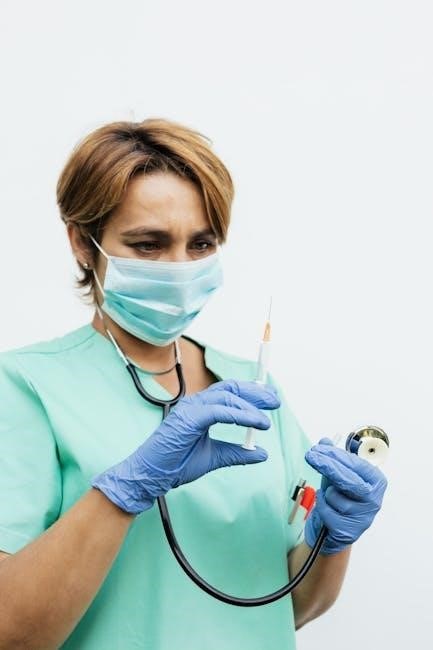
Legal and Regulatory Framework
OSHA regulations mandate strict protocols for preventing and managing needle stick injuries, ensuring workplace safety and compliance with exposure control plans to protect healthcare workers effectively.
OSHA Regulations and Compliance
OSHA’s Bloodborne Pathogens Standard requires employers to implement exposure control plans, including measures for preventing needle stick injuries. Employers must provide personal protective equipment (PPE), ensure proper sharps disposal, and train employees on safety protocols. Compliance involves regular updates to exposure plans, employee training, and record-keeping. Reporting incidents is crucial for maintaining compliance and ensuring prompt medical follow-up. Adherence to these regulations helps reduce occupational exposure risks and protects healthcare workers from bloodborne pathogens. Non-compliance can result in penalties, emphasizing the importance of strict adherence to OSHA guidelines in healthcare settings.
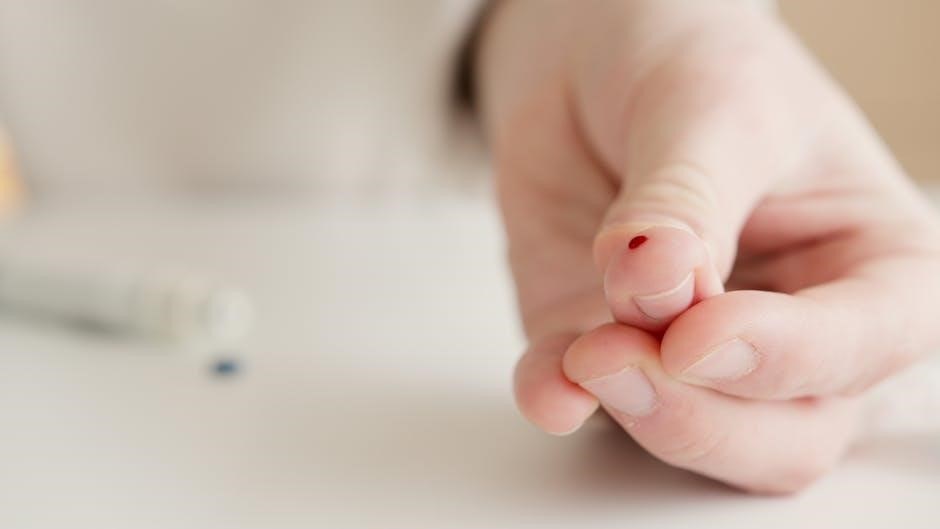
Workplace Policies and Documentation
Effective workplace policies and documentation are essential for managing needle stick injuries (NSIs). Employers must establish clear protocols for reporting incidents, including detailed documentation of the injury’s circumstances. Policies should outline immediate steps post-injury, such as wound care and disinfection, and ensure proper record-keeping for legal and compliance purposes. Documentation should include the type of needle involved, the procedure being performed, and the materials exposed. Employers are also required to maintain records of employee training on NSI prevention and post-exposure protocols. Accurate documentation helps in investigating incidents, identifying prevention opportunities, and ensuring compliance with occupational safety regulations. Regular updates to policies and thorough documentation practices are vital for safeguarding worker health and minimizing legal liabilities.
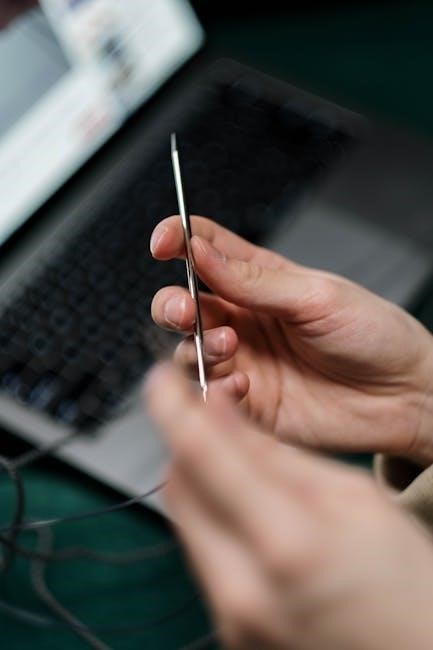
Epidemiology and Statistics
Global incidence of needle stick injuries (NSIs) remains significant, with higher rates in healthcare settings. Approximately 40% of injuries occur in high-risk procedural areas, impacting over 1 million healthcare workers annually. Despite advances in prevention, NSIs remain a critical occupational hazard, necessitating continuous monitoring and improved safety measures to reduce their prevalence.
Global Incidence and Risk Factors
Needle stick injuries (NSIs) are a significant global occupational hazard, particularly in healthcare settings. According to the World Health Organization (WHO), over 1 million healthcare workers (HCWs) experience NSIs annually. High-risk groups include surgeons, nurses, and laboratory staff, with approximately 40% of injuries occurring in procedurally intense areas. Risk factors include high patient turnover, insufficient training, and non-compliance with safety protocols. Developing regions face additional challenges due to limited access to safety-engineered devices and improper sharps disposal. These factors underscore the need for robust prevention strategies and global monitoring to reduce NSI incidence and mitigate associated risks effectively.
Psychological Impact
Needle stick injuries often cause significant stress, anxiety, and fear of infection among healthcare workers. Studies highlight the emotional trauma and mental health challenges following such incidents.
Stress and Trauma Associated with NSI
Needle stick injuries often result in significant psychological distress, including anxiety, fear, and emotional trauma. The risk of bloodborne pathogen exposure intensifies these feelings, leading to long-term mental health challenges. Many healthcare workers experience heightened stress due to the uncertainty of infection outcomes. This stress may manifest as post-traumatic stress disorder (PTSD), hypervigilance, or burnout. The emotional impact can affect job performance and overall well-being. Employers must provide robust support systems, including counseling and mental health resources, to address these issues. Early intervention and a supportive environment are crucial for mitigating the psychological effects of NSIs and ensuring workers’ mental health recovery. Proper training and awareness can also reduce anxiety by fostering confidence in safety protocols.
Case Studies and Examples
A healthcare worker experienced an NSI while administering medication, highlighting the importance of proper protocol adherence and immediate reporting to prevent severe consequences.
Real-Life Incidents and Lessons Learned
A nurse experienced a needle stick injury while preparing medication, resulting in exposure to a patient’s blood. Immediate reporting and PEP initiation were crucial in preventing infection. Another incident involved a lab technician who failed to follow disposal protocols, leading to a preventable injury. These cases highlight the importance of strict adherence to safety measures and timely reporting. Proper training and use of safety devices, such as needle guards, can significantly reduce risks. Organizations must emphasize protocol compliance and provide ongoing education to prevent such incidents. These real-life examples underscore the need for a proactive approach to NSI prevention and management.
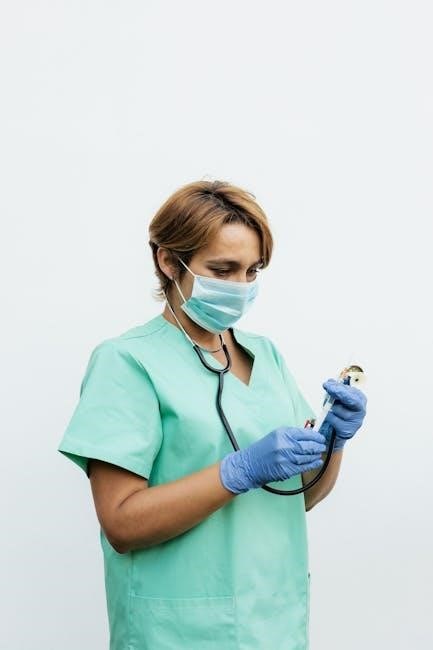
Technology and Innovation
Advancements in needle safety include safety-engineered devices and sharps containers, reducing injury risks. Automated disposal systems and real-time monitoring devices further enhance prevention and management strategies effectively.
Advancements in Needle Safety
Recent advancements in needle safety have significantly reduced the risk of needle stick injuries. Safety-engineered devices, such as self-sheathing needles and blunt-tip needles, are designed to prevent accidental punctures. Automated needle retraction systems and passive safety mechanisms ensure needles are covered immediately after use, minimizing exposure. Additionally, sharps containers with improved locking mechanisms prevent tampering and ensure safe disposal. These innovations, coupled with real-time monitoring systems, enhance adherence to safety protocols and reduce occupational hazards. The integration of smart technology in medical devices also provides alerts and training reminders, further mitigating risks. Such advancements are critical in safeguarding healthcare workers and ensuring compliance with global safety standards.
Key Takeaways and Future Directions
Key takeaways emphasize the importance of strict protocol adherence, proper training, and safety devices to minimize needle stick injuries. Future directions should focus on advancing needle safety technology, enhancing compliance with post-exposure prophylaxis, and improving reporting mechanisms. Continuous education and updated guidelines are essential to reduce risks and ensure effective management. Prioritizing workplace safety culture and encouraging open reporting channels can significantly mitigate the impact of NSIs. Ongoing research and collaboration between healthcare organizations and regulatory bodies will drive improved prevention strategies and better outcomes for affected individuals. By integrating these measures, healthcare settings can create a safer environment for workers and patients alike.